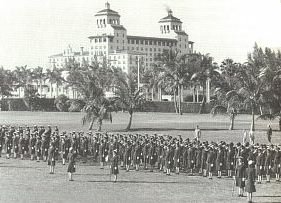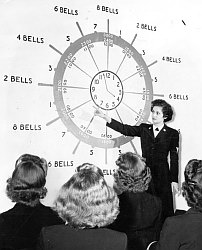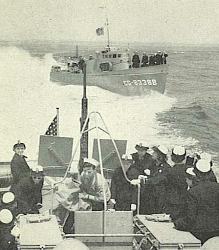|
Facts about the SPARS
Requirements for Joining
.
| . |
Enlisted Personnel |
Officers |
| Age |
Not less than 20 and not over 36. |
Not less than 20 and not over 50. |
| Citizenship |
Native-born American. If not native-born, applicant
or her parents must have naturalization papers. |
Native-born American. If not native-born, applicant
or her parents must have naturalization papers. |
| Dependents |
No children under 18 years of age. |
No children under 18 years of age. |
| Education |
At least 2 years of high school |
Must have a college degree or have passed two
years of college work and had at least two years of acceptable business
or professional experience. |
| Marriage |
A married woman may enlist provided her husband
is not in the Coast Guard. Unmarried women must agree not to marry until
after they have finished their period of training. After training, a SPAR
may marry a civilian or a service man who is not in the Coast Guard. |
A married woman may enlist provided her husband
is not in the Coast Guard. Unmarried women must agree not to marry until
after they have finished their period of training. After training, a SPAR
may marry a civilian or a service man who is not in the Coast Guard. |
| Character |
Furnish three character references |
Furnish three character references |
| Experience |
Submit a record of occupation since leaving school. |
Submit a record of occupation since leaving school. |
| Physical Examination |
Pass a Navy physical examination. Applicant must
be not less than five feet in height and less than 95 pounds in weight. |
Pass the Navy examination for candidates
for commissions. |
| Term of Enlistment |
For the duration of the war and not more than
six months thereafter |
For the duration of the war and not more than
six months thereafter |
.
All Applications should be made to the nearest
office of Naval Officer procurement.
.
Training
Starting on 17 February 1943, SPARS received
preliminary training at a time when Coast Guard instructional institutes
for women were still being set up. Enlisted SPARS trained at various places.
The first group of SPARS transferred from the WAVES received their training
at the Oklahoma's Agricultural and Mechanical University in Stillwater
which also became a specialist school for the yeaoman rating. The first
civilian women who enlisted as SPARS were trained at the Iowa State Teachers
College in Cedar Falls.
.
| More than 1,900 SPARS were sent to Hunter
College at the Naval Training Station in Bronx, New York, for a five-week
"boot training" course in military indoctrination (etiquette and customs),
naval uniforms and history, ships and aircraft, military organization and
regulations.
From the middle of 1943 until the end of 1944,
Coast Guard female recruits underwent more regimented initial training
in Florida at the leased Palm Beach Biltmore Hotel. More than 7,000 women
were indoctrinated in the 18 months where the training school at Palm Beach
existed. |
.v |

Regimental Review, US Coast
Guard Training Station,
Palm Beach, Florida
|
..
Until the end of war, SPARS taining was conducted
at Manhattan Beach, New York. About 1,900 SPARS went through the Training
Station Manhattan.
..
 |
.v |
Enlisted SPARS were trained in all the categories
offered to WAVES and in the schools already established for the WAVES.
In addition, they received special indoctrination by Coast Guard officers.
After the "boot training" some of the trainees
were ready for active duty, while others, selected on the basis of aptitude
tests went to specialist's schools for further specialists' training to
fit them for specific jobs. They could attend advanced training at the
yeoman school, the storekeeper schools or advanced radio schools. Such
specialized training lasted up to three more months.
|
.
| Officers were commissioned directly from civilian
life, based on their appearance and stamina, educational background (preferably
with college degrees in finance, communications and personal management)
and seafaring background (swimming, yachting or sailing) suitable for Coast
Guard maritime work.
Additionally, enlisted SPARS were encouraged
to apply as officer candidates. About 31 percent of the SPARS officers
were drawn from enlisted personnel eventually. Officer candidates attended
the Naval Reserve Midshipmen School in Massachusetts and often completed
schooling at the Coast Guard Academy in New London, Connecticut. Many had
to pass two months of advanced communication courses prior to final commissioning. |
.. |

SPARS officers learning
gunnery and maneuver of Coast Guard combat patrol craft. Most are already
experienced sailors and experts at handling yachts and motorboats prior
to joing the SPARS.
|
.
.
| Course |
Station |
Location |
Basic SPAR
before mid-1943 |
Campus, Stillwater
Campus, Cedar Falls
Naval Training School, Bronx |
Oklahoma's A&M University, Stillwater
Iowa State Teachers College, Cedar Falls
Hunter College, New York |
Basic SPAR
after mid-1943 |
Training Station Palm Beach |
Palm Beach, Florida |
Basic SPAR
since 1945 |
Training Station Manhattan |
Manhattan Beach, New York |
| Advanced Enlisted |
Yeoman School 1
Yeoman School 2 |
Cedar Falls, Iowa
Stillwater, Oklahoma |
| Advanced Enlisted |
Storekeeper School 1
Storekeeper School 2
Storekeeper School 3 |
Bloomington, Indiana
Boston, Massachusetts
Milledgeville, Georgia |
| Advanced Enlisted |
Radio School 1
Radio School 2 |
Madison, Wisconsin
Oxford, Ohio |
| Officer Candidate |
Naval Reserve Midshipmen School
Coast Guard Academy |
Northampton, Massachusetts
New London, Connecticut |
| Advanced Officer |
Communications School
Pay and Supply School |
Northampton, Massachusetts
Palm Beach, Florida |
.
SPARS Types of Duty
.

Enlisted SPAR dispatching communications |
.v |
Only a few jobs SPARS did were glamorous. Mostly, they were working
at desks formerly occupied by male officers and enlisted men.
SPARS women initially replaced men in shore
stations as receptionists, messengers, mail clerks, telephone and switchboard
operators, teletype experts, yeomen, storekeepers, radio operators and
technicians, drivers of military vehicles, pharmacist mates, cooks and
stewards. |
.
As the war progressed, Coast Guard women were
placed in charge of greater areas of previously male-only control.
For example, women soon had instrumental roles
in control of shipping through the Naval Port Director offices, in which
they served and often helped to coordinate. This essential task insured
that port shipping was quickly and efficiently routed to avoid mishaps
and undue delays. Such clearance and discharge responsibilities placed
women in the forefront of many military cargo and personnel handling decisions.
Port ammunition and explosives were added to this responsibility, so that
many women performed dangerous and hazardous assignments. |
.v |
 Signal Lamp Instruction
Signal Lamp Instruction
|
.
During the summer of 1943, it was decided
that SPARS should take over the very important and secret job of operating
LORAN Monitoring Stations at the Atlantic coasts of the United States.
.
 SPAR officers inspecting
LORAN stations in Alaska
SPAR officers inspecting
LORAN stations in Alaska
|
.v |
LORAN (Long Range Aid to Navigation) was a
classified electronic system developed during the war that enabled navigators
of air and surface craft to fix positions under all weather conditions.
Vessel dim-outs and even blackouts within the North Atlantic combat zone
was possible because of the valuable navigational aid of the LORAN system.
The work at the LORAN stations demanded highly
classified personnel with a special training. The SPAR operators combined
to complete 24-hour watches every day.
The LORAN unit at Chatham on Cape Cod was the
first one staffed completely by women. |
.
Examples of jobs taken over by SPARS:
.
| Accountants |
Gunners' Mates |
Pharmacists' Mates |
| Aerographers |
Hospital Attendants |
Photographer's Mates |
| Air Control Tower Operators |
Home Economists |
Public Reception Assistants |
| Aviation Machinists' Mates |
International Business Machine Operators |
Public Relations Assistants |
| Aviation Metalsmiths |
Legal Assistants |
Quartermasters |
| Bakers |
Line Assistants |
Radarmen |
| Card Punch Operators |
Link Trainer Operators |
Radio Communication Operators |
| Chaplains' Assistants |
Mail Clerks |
Radio Technicians |
| Chauffeurs |
Mechanics |
Stewards |
| Clerks |
Mess Attendants |
Storekeepers |
| Commissary Stewards |
Messengers |
Tabulators |
| Cooks |
Meteorlogists Technicians |
Telephone Operators |
| Coxwain |
Morale Workers |
Teletype Operators |
| Draftmen |
Motion Picture Technicians |
Tower Watchers |
| Electricians' Mates |
Motor Vehicle Drivers |
Typists |
| File Clerks |
Musicians |
Welfare Assistants |
| Financial Assistants |
Parachute Riggers |
Yeomen |
.
.
Officers became especially valuable as communications
directors and disbursing agents in Coast Guard Pay and Supply. They were
responsible for allotment accounting, ration and general mess (control
of dining facilities), clothing and procurement, as well as transportation
supervision.
Duties of Officers:
.
| Administrative Assistants |
Instructors at Training Posts |
Morale and Welfare Recreation Workers |
| Commissary Officers |
Legal Officers |
Officer and Enlisted Procurement Officers |
| Communiators |
Liaison |
Personnel Officers |
| Engineers |
Medical Technicians |
Supply Technicians |
| Finance Officers |
Metereologists |
Public Relation Officers |
.
..
SPARS worked within the following offices and under the following
officers.
.
I. Within the Office of The Commandant of the US Coast
Guard
.
| Commandant's Office |
Administrative Management Division |
| Advisory Board |
Public Relations Division |
| Merchant Marine Council |
Special Assistants |
.
II. Within offices of the Headquarters and the Assistant
Commandant
.
Office Services Division
Statistical Division Chief Personnel Officer |
Ordnance and Gunnery Division |
| Assistant Chief Personnel Officer |
Port Security Division Chief Finance and Supply Officer |
| Auxiliary Division |
Assistant Chief Finance and Supply Officer |
| Medical Division (note: actual female nurses and doctors from Public
Health Service) |
Administrative Assistant |
| Women's Reserve Division Inspector in Chief (Inspection Division) |
Planning and Procedures Officer |
| Intelligence Division |
Accounting Division |
| Legal Division |
Budget and Reports Division |
| Chief Operations Officer |
Supply Division Engineer in Chief |
| Operations Planning Officer |
Assistant Engineer in Chief |
| Allowance Division |
Aeronautical Engineering Division |
| Aviation Division |
Naval Engineering Division |
| Merchant Marine Inspection Division |
Contract Services Division |
| Merchant Marine Personnel Division |
Materiel Reports Division |
.
III. Under the following officers within each Coast
Guard/Navy District
(see SPARS Duty Stations)
.
| Headquarters of the District |
Marine Inspection Officer |
| Military Morale Officer |
Ordnance and Gunnery Officer |
| Personnel Procurement Officer |
Port Security Officer |
| Records and Assignments Officer |
Vessel Operations Officer |
| Temporary Reserve Personnel Officer |
Intelligence Officer |
| Training Officer |
Law Officer |
| Civilian Personnel Officer |
Finance and Supply Officer |
| District Director of the Auxiliary Medical Officer and Engineer
Officer |
Budget and Accounting Officer |
| Civil Engineer Officer |
Clothing Officer |
| Communications Engineer Officer |
Commissary Officer |
| Marine Engineer Officer |
Pay and Disbursing Officer |
| Aids to Navigation Officer |
Supply Officer |
| Beach Patrol Officer |
Transportation Officer |
| Communications Officer |
Operations Officer |
.
SPARS Duty Stations
.
| Coast Guard District * |
Headquarters |
Location |
| First |
Boston, Massachusetts |
New England |
| Third |
New York, New York |
Northeast |
| Fourth |
Philadelphia, Pennsylvania |
Mid-Atlantic north |
| Fifth |
Norfolk, Virginia |
Mid-Atlantic south |
| Sixth |
Charleston, South Carolina |
Southeast |
| Seventh |
Miami, Florida |
Florida, Bahamas |
| Eighth |
New Orleans, Louisiana |
Gulf coast |
| Ninth |
Chicago, Cleveland, St. Louis |
Great Lakes and Mississippi River |
| Eleventh |
San Diego, California |
West Coast south |
| Twelfth |
San Francisco, California |
West Coast middle |
| Thirteenth |
Seattle, Washington |
Northwest |
| Fourteenth ** |
Honolulu, Hawaii |
Hawaii and Pacific |
| Seventeenth ** |
Ketchikan, Alaska |
Alaska, Aleutian Islands |
| * |
No Second, Fifteenth, or Sixteenth
Districts existed. Coast Guard Districts were also known as Navy Districts. |
| ** |
SPARS could be assigned to the
Fourteenth and Seventeenth Districts (Hawaii and Alaska) after 27 September
1944, because of a basic Reserve Act amendment that removed restrictions
where SPARS could serve. Both were important duty stations and many SPARS
eventually served in both places. |
.
Payment
.
SPARS received the same rates of pay as Coast Guardsmen.
.
Enlisted SPARS
.
| Rate |
Monthly Base Pay |
Subsistence |
Total |
| Apprentice Seaman |
$50 |
$82.50 |
$132.50 |
| Seaman, Second Class |
$54 |
$82.50 |
$136.50 |
| Seaman, First Class |
$66 |
$82.50 |
$148.50 |
| Petty Officer Third Class |
$78 |
$82.50 |
$160.50 |
| Petty Officer Second Class |
$96 |
$82.50 |
$178.50 |
| Petty Officer, First Class |
$114 |
$82.50 |
$196.50 |
| Chief Petty Officer |
$126 |
$82.50 |
$208.50 |
Additionally, enlisted SPARS received $200 uniform allowance.
.
SPARS Officers
.
| Rank |
Monthly Base Pay |
Allowances |
Total |
| Ensign |
$150 |
plus subsistence and quarters allowance |
about $216 |
| Lieut. (jg.) |
$166.67 |
plus allowances |
about $247 |
| Lieut. (sg.) |
$200 |
plus allowances |
about $296 |
| Lieut. Comdr. |
$250 |
plus allowances |
. |
Additionally, SPARS officers received $250 uniform allowance.
.
[ I. Development
]..[
II. Facts about the SPARS ]..[
III. Uniforms ]..[
IV. Sources ]
|
